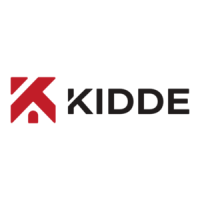General Information
06-237619-001 1-1 April 2020
CHAPTER 1
GENERAL INFORMATION
1-1 INTRODUCTION
The Kidde Fire Systems Inert Gas Engineered Fire Suppression System (Kidde
®
IGS) using IG-
100 or IG-55 (herein refer to collectively as the “Agent”) are designed to suppress fires in
specific hazards or equipment located where an electrically non-conductive Agent is required
and where an electrically non-conductive Agent with little to no clean up is required. These
Agents are approved by the EPA, NFPA, and ISO for use in fire suppression systems. Use Kidde
IGS as a total flooding system for protection against hazards that are enclosed or for protecting
equipment that includes an enclosure within itself that will contain the Agent.
Key features of all the offered inert Agents are:
• Zero ozone depletion potential
• Zero global warming potential
• Atmospheric lifetime of zero days
• Colorless, with low odor and no particulate or residue allowing for minimal business disrup-
tion after a discharge
• Electrically non-conductive
For specific design concentrations see Section 3-3.
1-1.1 Use
Kidde IGS is used to extinguish fires in almost all flammable substances with only a few
exceptions. The Kidde IGS itself does not leave any hazardous substances after a release.
Cleaning up from the fire involves only repairing parts damaged by the fire; machine downtime
and other secondary damage can therefore be kept to a minimum.
The density of the Kidde IGS gases are similar to that of atmospheric air, therefore longer hold
times are expected as opposed to other heavier clean agents. The gases used in the Kidde IGS
are non-conductive and therefore suitable for the extinguishment of fires involving electrical
and electronic equipment.
The normal design concentrations used in Kidde IGS will result in an oxygen concentration
above 10% and thus are acceptable for protecting normally occupied enclosures.
Kidde IGS is also useful for extinguishing fires involving:
• Flammable and combustible liquids
• Sub floors and other concealed spaces
• Delicate artifacts such as clothing, paintings, and other high-value items
• In places where other extinguishing media could be directly destructive
Note: Fires in solid materials (deep-seated) require that the design concentration is main-
tained for a sufficient period of time (hold time) to achieve total extinguishment.

